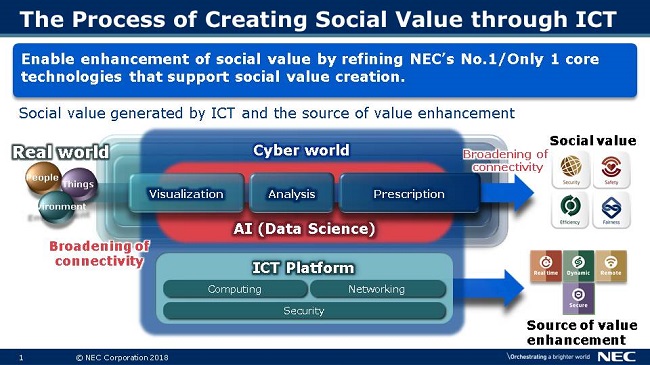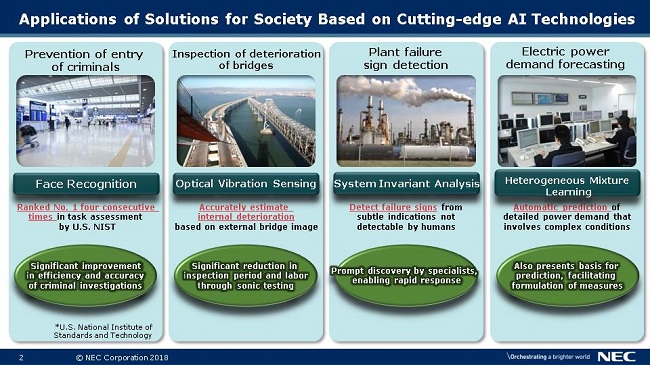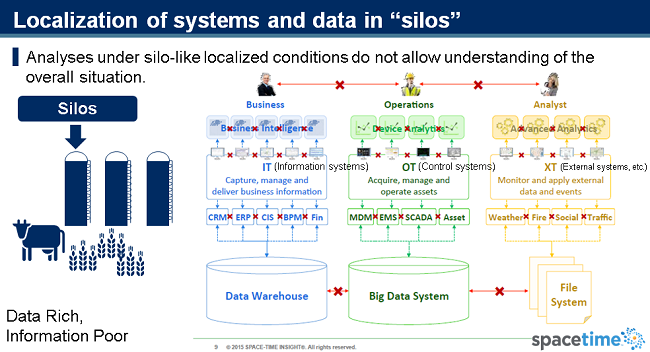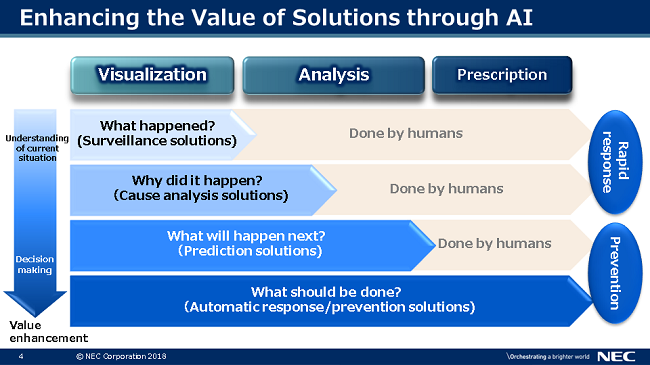Energy Conservation by applying AI – Looking back on the transition and the challenge of AI, the possibility of utilization of AI for energy conservation is discussed while referring to the challenge of NEC Corp. for utilization of AI –
How AI will move forward in the future? How will it be used for energy management for energy saving? Looking back on the transition and the challenge of AI, the possibility of utilization of AI for energy conservation is discussed while referring to the challenge of NEC Corp. for utilization of AI.
There is no clear definition of AI
Over the last few years, artificial intelligence (AI) has once again been attracting attention. This AI is also the driving force behind Industry 4.0, the fourth industrial revolution in the manufacturing industry. In addition, without limitation to the manufacturing industry, AI also holds the key to increasing business efficiency and improving convenience and safety in peoples’ lives, so that companies and administrative organizations around the world are positively proceeding with the research and development and introduction of AI. Needless to say, this is no exception in the field of energy efficiency & conservation (hereinafter “EE&C”).
But what actually is AI? Regarding this question, many people would probably be hard-pressed to give an explanation of AI. Actually, there is no clear definition of AI, and in the present situation opinions are split even between academics and researchers. If pushed to give an explanation, many people would probably cite “information processing by machines which have been given human-like intellect and intelligence, or this technology”. However, because it is not possible to delineate what is indicated by “human-like intellect and intelligence”, and how far this has to be developed before it can be considered as “human-like”, it is probably not surprising that definition is not possible.
The birth of “deep learning” provides an opportunity to re-ignite the AI boom
The expression “artificial intelligence” or AI is reputed to have first appeared in the United States in the 1950s. This new system, consisting of flexibly considering and responding to a given issue in the way that humans do, was quickly embraced by many people, who immersed themselves in research and development while envisioning a variety of dreams in their heads. For example, even at the stage in 1958, people were making predictions such as “a computer will probably beat a chess champion within the next 10 years”. This was the first AI boom.
However, in actual fact, at the technological level in those days computers were only capable of creating programs for implementing simple reasoning and searches, so if problems occurred even in a little complicated manner the computers were incapable of . Of course there was no chance of a computer beating a human at chess, and people should have to wait another 40 years or so before it happened in 1997.
However, even though the dreams that people had envisioned were not actualized, the rapid progress in technological development from the middle through the second half of the 20th century made it possible to realize various things using computers. At the beginning of the 1980s, commercial databases were also developed one after another. “Expert systems”, which were created from AI research processes, also began to attract attention from around this time. This type of computer system, which emulated the decision-making abilities of human specialists, were introduced into various situations including all types of businesses. In the wake of the second AI boom, support for and investment in AI research and development was stimulated in many countries and enterprises.
Among these activities, “neural networks” attracted particular attention. These adopted the concept that if a computer is created which mimics the nerve cell circuits of the human brain, in the same way as the human brain it should allow “learning” of even more knowledge and enable more complex responses to be made. However, similarly to the time of the first AI boom this research encountered a major obstacle. That is, the computers at the time were still limited in their mimicking of the hierarchical structure of the complex nerve cells in human beings. The recent return to viewing AI with enthusiasm is due to the appearance of a revolutionary technology which has enabled the overcoming of this obstacle. This technology is “deep learning”.
Towards more dynamic EE&C through the combination with AI
“Machines which have been given human-like intellect and intelligence” are basically called computers. While computers normally operate according to programs that have been developed by humans, in the case of AI in addition to the human-developed programs, the computer analyzes data itself and has functions which create models made up of regularities and rules. This is known as “machine learning”, and deep learning is one of the developed type of machine learning. The main reason why the previous AI booms lost momentum was, as previously mentioned, the low level of the computer technology which meant that the machine learning was so primitive that it was nowhere near matching human intelligence. However, following the progress of the research into neural networks since the latter half of the 20th century, the overlaying of these network layers similar to human brain cells has realized deeper, faster learning capabilities, dramatically improving the learning accuracy and data analyzing abilities of AI. This is the main reason why AI is receiving high evaluation.
However, even these days it is still not possible for AI to accomplish the same things as humans. Basically, AI provides a tool which substitutes for human intellectual work by applying this high cognitive ability and analytical strength to data that has already been prepared, and it by no means constitutes an all-encompassing solution.
Of course, it goes without saying that AI is an extremely useful tool. For example, the fact that automatic driving technology has finally reached the practical implementation stage is also largely due to the evolution of AI. Further, in the medical field there are reports that seem almost too good to be true relating to leukemia, which is difficult even for doctors to diagnose, being discovered in around 10 minutes using AI. In this way, by clarifying the objectives and providing suitable information to enable learning, AI creates great results. Also in the field of EE&C, although systems such as EMS making practical use of AI have already been introduced, it is expected that the use of deep learning will enable further precision and efficiency to be going forward. Further, the combination with the Internet of Things (IoT) will enable the promotion of dynamic EE&C throughout the society rather than just in equipment, building, and factory units.
Creation of new social value based on AI
Actually, organizations including Japanese manufacturers leading in the research and development of AI are beginning to positively work towards the goal of creating new social value through implementing energy management utilizing AI. NEC is also one of these manufacturers, and beginning with OCR (postal address reading sorters) in the 1960s, NEC has been leading in the research and development and commercialization of AI for more than 50 years. Additionally, from image and video recognition represented by fingerprint recognition and face recognition to language and meaning understanding, machine learning, predictive analytics, optimal planning and control, NEC is creating and maintaining the world’s top level of AI technologies, which sometimes has the world’s only one capability.
In this company, while making best use of each of these leading-edge AI technologies branded under the “NEC the WISE” portfolio, it realizes advanced “visualization”, “analysis”, and “prescription” through fusing big data and ICT technologies, and intends to develop a wide range of social solution businesses. (See Figure 1.)
Figure 1: The Process of Creating Social Value through ICT
These contents are wide-ranging, stretching from public security and safety management to effective infrastructure operations, including for example, preventing criminals from gaining entry to countries by utilizing facial recognition, and optical vibration analysis technology which enables highly precise estimations of the internal degradation of bridges using exterior imaging. The contents can be said to cover almost all the activities in peoples’ social lives.
Even among these contents, NEC recognizes that energy management is also one of the major issues. For example, electricity demand is easily influenced by weather conditions comprising temperature and humidity. By accumulating this weather and electricity demand data and applying AI machine learning (heterogeneous mixture learning technology), electricity demand can be predicted with higher precision. Additionally, in facilities which hold extensive amounts of equipment, such as factories and power transmission and distribution systems, equipment breakdowns and malfunctions will directly result in energy losses. To address this, invariant analysis technology in which AI analyzes data collected from several tens of thousands of sensors to detect failure symptoms from slight sign that cannot be detected by humans, has already entered the practical stage. (See Figure 2.)
Figure 2: Applications of Solutions for Society Based on Cutting-edge AI Technologies
Storing data does not simply allow full use of AI
Of course, it is also important to consider how to appropriately analyze the accumulated data and utilize it for EE&C and eventually business management. Simply storing data as a temporary measure will not provide satisfactory results, even if advanced analyses are implemented. Although AI tends to attract attention for its future predictions, its basic data analyses are also extremely important. Unless the precision is improved in these areas, the attractions of AI will be reduced by half in terms of eliminating dependencies on individual cases.
In addition, the linking of data using AI is also indispensable. Taking an example of power transmission and distribution systems, if the objective is to make these more efficient, it is essential to gain an understanding of the condition of the entire system. However, in the current situation very often the facility management systems and patrol inspection systems in each part are completely different according to each vendor and are not linked, so that in many cases cross-sectional management is not possible. This means that the carefully accumulated data will also become a treasure with no practical use. This is known as the localization of data in silos, (See Figure 3.) or Data Rich, Information Poor. The fact that each company manages the system separately also exerts an adverse effect on improving the efficiency of operations and maintenance, and on the transparency of business management relating to the aspect of expenses. As it is planned to realize the separation of transmission and distribution from power generation in Japan in 2020, once this system begins operating, circumstance will become increasingly severe.
Figure 3: Localization of systems and data in silos
In order to resolve these conditions, NEC has been cooperating with the Sacramento Municipal Utility District (SMUD) and SpaceTime Insight (STI) in the US since 2017, and has begun providing smart energy solutions including “solutions for advanced facilities management” to Japanese electric power companies that enable cross-sectional analyses to be implemented across multiple systems.
SMUD is the fifth–largest electric power company in the US, and has become the first company in the country to attain the government’s requirement to maintain 20% renewable energy. To achieve this, it reduced the distribution losses and the losses due to the worsening of facility efficiency through unified management of data localized in silos and analysis of the load data using AI, and secured the electricity quality while introducing renewable energy. Other partner, STI, is a software company which has extensive experience of introducing many energy management systems to US electric power companies. Through the collaboration that combines the know-how of both these companies with NEC’s advanced AI technologies, they are aiming to achieve even more advanced energy utilization.
Going forward, while proceeding to introduce AI, it will likely be necessary for us not only to strive to improve our in-house technologies, but also to enter into cooperation with outside experts in the way that is described above in order to enhance this value.
Rather than depriving people of work, AI yields opportunities for creating new work
The introduction of AI will continue in the future, and in addition if machine learning due to data accumulation progresses further, EE&C will become even much higher level. At the same time, this will also mean that the work areas currently conducted by humans will become more and more limited. (See Figure 4.) In fact, although there is always speculation following the progress of AI that “won’t AI take away our work, making human intervention unnecessary? ” which is by no means the case. In all business, the final judgments are always made by humans, and it is also the role of humans to let AI learn more. As explained earlier, AI is merely a tool for precisely and speedily implementing knowledge work for humans. If the efficiency of the work is increased using this tool, surplus time created by it can be utilized for newly implementing creative activities.In another words, it enables humans to conduct the activities most suited to their abilities.
In addition, depending on the purpose of the introduction, AI acts as a driving force which differs in its mechanisms and contents. When introducing AI, it is essential to clarify the objectives. Here, although it is desirable if possible for the manufacturer to analyze customer needs and offer proposals which respond to these requirements, unfortunately there is still a shortage of these kinds of capabilities in Japan. From now on, it will probably become necessary not only to create the technologies, but also to train people who perform as consultants and analysts.
Figure 4: Enhancing the Value of Solutions through AI
*Space-Time was acquired by Nokia in May 2018. NEC continues the collaborations with SMUD and Nokia since then.
Source: Monthly Magazine “Energy Conservation”





